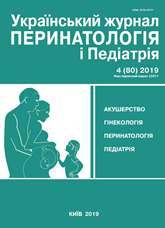Features of perinatal diagnosis and tactics for congenital heart defects (the experience of si «Institute of pediatrics, obstetrics and gynecology named of academician o.m. Lukyanova of the nams of Ukraine», 2015–2019)
DOI:
https://doi.org/10.15574/PP.2019.80.24Keywords:
congenital heart defects, fetus, pregnancy, ductus arteriosus, foramen ovaleAbstract
Currently, congenital heart defects (CHD) remain the most common in the structure of all developmental abnormalities and often cause mortality of fetuses and newborns in the first month of life. Due to the success of cardiac surgery, complex reconstructive surgery for CHD, which were previously considered inoperable, became possible. Under these conditions, the main task in organizing assistance to children with CHD complications is the modern diagnosis and timely assistance in a heart surgery clinic. Most CHD are diagnosed during screening examinations of pregnant women with fetal echocardiography. However, it should be noted that not all CHD can be detected in utero in the fetus, and in such cases, the provision of optimal cardiac surgery for newborns may not be timely.Purpose — to justify the perinatal tactics for CHD of the newborn, before being transferred to the cardiac surgery center.
Patients and methods. All pregnant women underwent complete fetal echocardiography with the establishment of topical diagnosis, functional assessment of the heart ventricles, as well as assessment of hemodynamic disturbances in the fetoplacental system, and identification of concomitant pathology. The optimal time chosen for examination of the fetus was 20–22 and 30–32 weeks of pregnancy. During the period of 2015–2019 a total of 8457 pregnant women were examined according to the algorithm developed by us in the State Institution «Institute of Pediatrics, Obstetrics and Gynecology named after Academician A.N. Lukyanova of the NAMS of Ukraine». In 144 of them, hemodynamically significant congenital heart defects were diagnosed prenatally. In order to correctly assess the condition of the child at birth, the prenatal history and data of the ultrasound examination of the fetus have been carefully studied. The children underwent complete clinical and instrumental examination. Prenatal and postnatal ultrasound was performed on AcusonX300 (Siemens, Germany) and MyLabTwice (Esaote, Italy) devices.
Results and conclusions. Considering the literature data and the analysis of our own studies, pre- and postnatal management tactics have been developed for the detection of CHD in the fetus and newborn to provide timely specialized care to this category of patients to reduce mortality prevention of complications, increasing the duration and quality of children life.
The research was carried out in accordance with the principles of the Helsinki Declaration. The study protocol was approved by the Local Ethics Committee participating institutions. The informed consent of the patient was obtained for conducting the studies.
No conflict of interest were declared by the authors.
References
Zinkovskyi MF, Lazoryshynets VV, Rudenko NN. (2013). Pryntsypy likuvannia ditei z vrodzhenymy vadamy sertsia. Doktor. 2: 23–25.
Lukianova I.S., Truba Y.P., Medvedenko G.F., Zhadan O.D., Ivanova L.A. Congenital anomalies of the aortic arch: perinatal management. Perinatologiya i pediatriya. 2 (62): 16–21. https://doi.org/10.15574/PP.2015.62.16
Lukyanova IS, Medvedenko GF, Zhuravel IA, Tarasyuk BA, Ivanova LA. (2016). Prenatalnyie i postnatalnyie paralleli pri kriticheskih vrozhdennyih porokah serdtsa u ploda. Akusherstvo, hinekolohiia, henetyka. 3(2): 31–38.
Yaschuk NS, Koval AP, Ditkovskiy IA, Cherpak BV, Lukyanova IS, Davyidova YuV, Lazorishinets VV. (2016). Interventsii u ploda pri vrozhdennyih porokah serdtsa. Visnyk sertsevo-sudynnoi khirurhii. 1: 91-94.
Dolk H, Loane M, Garne E (2011). Congenital Heart Defects in Europe Prevalence and Perinatal Mortality, 2000 to 2005. Circulation. 123: 841–849. https://doi.org/10.1161/CIRCULATIONAHA.110.958405; PMid:21321151
Donofrio МТ, Moon-Grady AJ, Hornberger LK et al. (2014, May 13). Diagnosis and Treatment of Fetal Cardiac Disease A Scientific Statement From the American Heart Association. Circulation: 1–61.
Francine R, Pascale S, Aline H. (2014). Congenital Anomalies: Prevalence and Risk Factors. Universal Journal of Public Health. 2 (2): 58–63.
Freud LR, McElhinney DB, Marshall AC, Marx GR et al. (2014, Aug 19). Fetal aortic valvuloplasty for evolving hypoplastic left heart syndrome: postnatal outcomes of the first 100 patients. Circulation. 130 (8): 638–645. https://doi.org/10.1161/CIRCULATIONAHA.114.009032; PMid:25052401 PMCid:PMC4299861
Hamilton LE, Lew ЕО, Matshes EW. (2011). Grown-Up Congenital Heart Disease and Sudden Death in a Medical Examiner's Population. Journal of Forensic Sciences. 56: 5: 1206–1212. https://doi.org/10.1111/j.1556-4029.2011.01807.x; PMid:21644986
Linde D, Konings E et al. (2011). Birth prevalence of congenital heart disease worldwide. A systematic review and meta-analysis. J Am Coll Cardiol. 58: 2241–2247. https://doi.org/10.1016/j.jacc.2011.08.025; PMid:22078432
Moon-Grady AJ, Morris SA, Belfort M et al. (2015, Jul 28). International Fetal Cardiac Intervention Registry: A Worldwide Collaborative Description and Preliminary Outcomes. J Am Coll Cardiol. 66 (4): 388–399.
Tworetzky W, McElhinney DB. (2009). In Utero Valvuloplasty for Pulmonary Atresia With Hypoplastic Right Ventricle: Techniques and outcomes. Pediatrics. 124: 510–518. https://doi.org/10.1542/peds.2008-2014; PMid:19706566 PMCid:PMC4235279
Tulzer G, Arzt W. (2013). Fetal cardiac interventions: Rationale, risk and benefit. Semin Fetal Neonatal Med. 18 (5): 298–301. https://doi.org/10.1016/j.siny.2013.04.002; PMid:23764271
Downloads
Issue
Section
License
The policy of the Journal “Ukrainian Journal of Perinatology and Pediatrics” is compatible with the vast majority of funders' of open access and self-archiving policies. The journal provides immediate open access route being convinced that everyone – not only scientists - can benefit from research results, and publishes articles exclusively under open access distribution, with a Creative Commons Attribution-Noncommercial 4.0 international license(СС BY-NC).
Authors transfer the copyright to the Journal “MODERN PEDIATRICS. UKRAINE” when the manuscript is accepted for publication. Authors declare that this manuscript has not been published nor is under simultaneous consideration for publication elsewhere. After publication, the articles become freely available on-line to the public.
Readers have the right to use, distribute, and reproduce articles in any medium, provided the articles and the journal are properly cited.
The use of published materials for commercial purposes is strongly prohibited.

